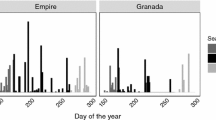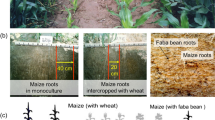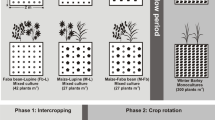Abstract
With renewed interest in the use of ecologically-designed, sustainable agricultural systems for temperate regions of the world, agroforestry is being proposed as an alternative to intensive production of crops in monocultures. However, the knowledge-base for understanding and managing complex, multi-strata systems worldwide is limited, particularly so for temperate regions. We examined an alley cropping system in the midwestern US where maize (Zea mays L.) is grown in alleys between tree rows of either black walnut (Juglans nigra L.) or red oak (Quercus rubra L.). During a course of ten years, crop yields in rows adjacent to tree rows declined by 50% or more. With the experimental introduction of barriers to separate tree and crop root systems, yields in the rows near trees were equal to those of the center row (and monoculture). Irrespective of a high correlation between photosynthetically active radiation and net photosynthesis, shading did not have a major influence on crop yield. At this stage of system development (11 year old trees), influence of incident PAR on crop yield seems to be minimal. Subsequent papers in this series examine the sharing of belowground resources between trees and crops to quantify the competitive interactions that impact crop yields and their implications for economic return to the farmer.
Similar content being viewed by others
References
Benjamin TJ, Hoover WL, Seifert JR and Gillespie AR (2000) Defining competition vectors in a temperate alleycropping system in the midwestern USA: 4. The economic return of eco-logical knowledge. Agrofor Syst 48: 79–93
Chirko CP, Gold MA, Nguyen PV and Jiang JP (1996) Influence of direction and distance from trees on wheat yield and photosynthetic photon flux density (Qp) in a Paulownia and wheat intercropping system. For Ecol Manage 83: 171–180
Corlett JE, Black CR, Ong CK and Monteith JL (1992) Above-and below-ground interactions in a leucaena/millet alley cropping system. II. Light interception and dry matter production. Agric For meterol 60: 73–91
Fischer KS and Palmer AFE (1984) Tropical maize. In: Goldsworthy PR and Fisher NM (eds). The Physiology of Tropical Field Crops, pp 13–248. John Wiley and Sons Ltd, Chichester, UK
Garrett HE and Buck LE (1997) Agroforestry practice and policy in the United States of America. For Ecol Manage 91: 5–15
Gold MA and Hanover JW (1987) Agroforestry systems for the temperate zone. Agrofor Syst 5: 109–121
Gordon AM and Newman SM (1997) Temperate Agroforestry Systems. CAB International, New York, 269 pp
Hahn JT and Hansen MH (1991) Cubic and board foot volume models for the Central States. North J Appl For 8: 47–57
Jose S (1997) Interspecific interactions in alley cropping: the physiology and biogeochemistry. PhD Thesis, Purdue University, West Lafayette, IN, USA, 171 pp
Jose S and Gillespie AR (1998a) Allelopathy in black walnut (Juglans nigra L.) alley cropping: I. Spatio-temporal variation in soil juglone in a black walnut – corn (Zea mays L.) alley cropping system in the midwestern US. Plant Soil 203: 191–197
Jose S and Gillespie AR (1998b) Allelopathy in black walnut (Juglans nigra L.) alley cropping: II. Effects of juglone on corn (Zea mays L.) and soybean (Glycine max L. Merr.) growth and physiology. Plant Soil 203: 199–205
Jose S, Gillespie AR and Seifert JR (2000a) Defining competition vectors in a temperate all-eycropping system in the midwestern USA: 2. Competition for water. Agrofor Syst 48: 41–59
Jose S, Gillespie AR, Seifert JR, Mengel DB and Pope PE (2000b) Defining competition vectors in a temperate alleycropping system in the midwestern USA: 3. Competition for nitrogen and litter decomposition dynamics. Agrofor Syst 48: 61–77
Karim AB, Savill PS and Rhodes ER (1993) The effects of between-row (alley widths) and within-row spacing of Gliricidia sepium on alley-cropped maiz in Sierra Leone: growth and yield of maiz. Agrofor Syst 24: 81–93
Lawlor DW (1995) Photosynthesis, productivity and environment. J Exp Bot 46: 1449–1461
Lawson TL and Kang BT (1990) Yield of maize and cowpea in an alley cropping system in relation to available light. Agric For Meterol 52: 347–357
Leihner DE, Ernst-Schaeben R, Akondé TP and Steinmüller N (1996) Alley cropping on an Ultisol in subhumid Benin. Part 2: Changes in crop physiology and tree crop competition. Agrofor Syst 34: 13–25
Little TM and Hills FJ (1978) Agricultural experimentation. John Wiley and Sons, New York, 350 pp
Long SP and Hallgren JE (1985) Measurement of CO2 assimilation by plants in the field and the laboratory. In: Coombs J, Hall DO, Long SP and Scurlock JMO (eds) Techniques in Bioproductivity and Photosynthesis (second edition), pp 62–94. Pergamon Press, Oxford
Matson PA, Parton WJ, Power AG and Swift MJ (1997) Agricultural intensification and ecosystem properties. Science 277: 504–509
Moffat AS (1997) Higher yielding perennials point the way to new crops. Science 274: 1469–1470
Monteith JL (1972) Solar radiation and productivity in tropical ecosystems. J Appl Ecol 9: 747–766
Ong CK and Huxley PA (1996) Tree-Crop Interactions: A Physiological Approach. CAB International, UK, 386 pp
Ong CK, Corlett JE, Singh RP and Black CK (1991) Above and below ground interactions in agroforestry systems. For Ecol Manage 45: 45–57
Sanchez PA (1995) Science in agroforestry. Agrofor Syst 30: 5–55
Singh RP, Ong CK and Saharan N (1989) Above and below ground interactions in alley cropping in semiarid India. Agrofor Syst 9: 259–274
Smith WB (1985) and equations to estimate biomass in the North Central Region. USDA For Serv Res Pap RP-268, 6 pp
Williams PA and Gordon AM (1995) Microclimate and soil moisture effects of three intercrops on the rows of a newly-planted intercropped plantation. Agrofor Syst 29: 285–302
Author information
Authors and Affiliations
Corresponding author
Rights and permissions
About this article
Cite this article
Gillespie, A.R., Jose, S., Mengel, D.B. et al. Defining competition vectors in a temperate alley cropping system in the midwestern USA: 1. Production physiology . Agroforestry Systems 48, 25–40 (2000). https://doi.org/10.1023/A:1006285205553
Issue Date:
DOI: https://doi.org/10.1023/A:1006285205553




